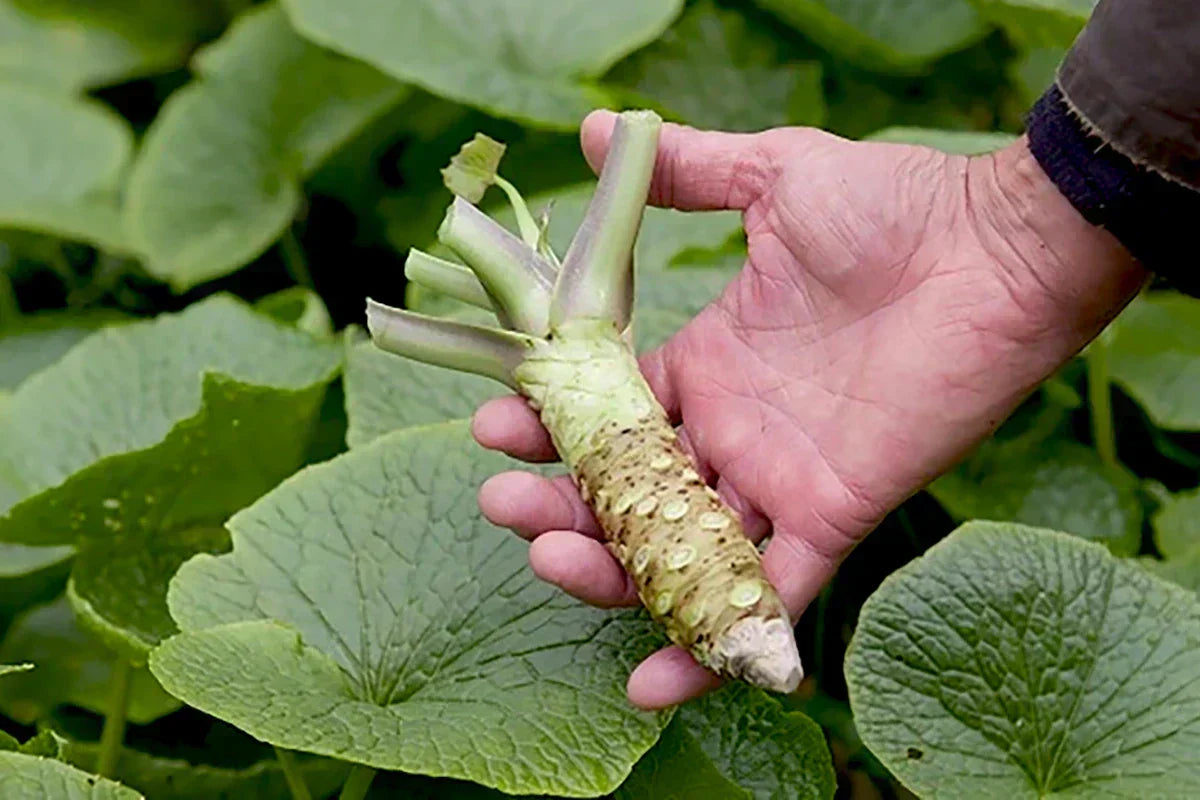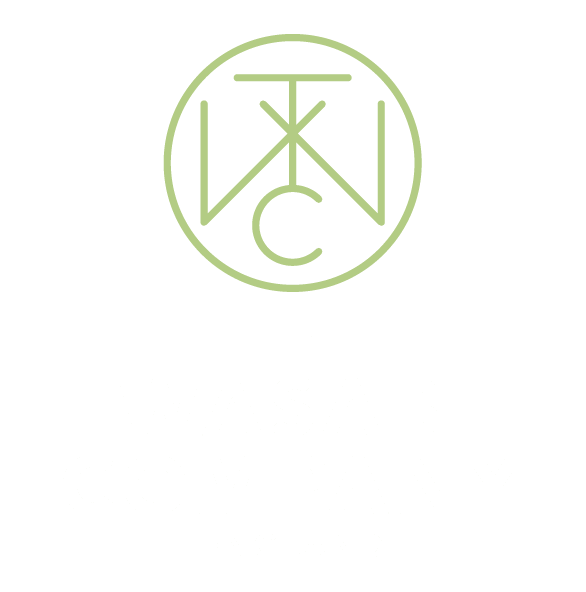
Fresh Japanese wasabi is the perfect, zingy complement to the delicate flavours of sushi and sashimi, and thanks to the incredible popularity of Japanese cuisine, many more people around the world are becoming fans of this spicy green paste.
But did you know that there’s a strong chance you’ve never actually tasted real wasabi?
Wasabi is notoriously difficult to grow, and with the expense of importing this rare plant to other countries, many Japanese restaurants and speciality Asian supermarkets in the West only use a very small percentage of actual wasabi in their “wasabi” pastes. In fact, Western wasabi products can contain as little as 1% real wasabi!
Nothing compares to the real thing – especially if you want to cook authentic Japanese cuisine with powerful yet effortlessly balanced flavours. Learn more about what wasabi is, what it tastes like, and how to spot the difference between real and fake wasabi below.

What is real wasabi?
Wasabi, or Japanese horseradish (scientific name Wasabia japonica), is a plant belonging to the Brassicaceae family, which also includes horseradish, radish, broccoli, cabbage, and mustard plants. Wasabi plants are native to Japan and grow naturally near high-altitude woodland streams, but for centuries they have also been deliberately cultivated due to their status as a highly coveted Japanese ingredient, particularly in popular dishes like sushi.
Today, Japan’s Shizuoka Prefecture is their main producer of wasabi, with significant wasabi production also located in Nagano Prefecture, Iwate Prefecture, and Shimane Prefecture.
In total, the vast majority of the world’s wasabi crop still comes from Japan, but in recent years, other countries such as Spain, Australia, Italy and the UK have started growing wasabi plants on a smaller scale, leading to the greater availability of real wasabi outside of Japan.
What is wasabi for in sushi?
Wasabi is commonly added to sushi dishes to enhance their delicate flavour. Wasabi can be added on the side, placed inside maki rolls (often in a layer between the rice and fish), or mixed into soy sauce to create a spicy and savoury condiment.

Want to learn more about how to make sushi with fresh wasabi and other authentic ingredients? Read our all about sushi blog post!
Wasabi plants
The wasabi rhizome – which is the lower part of the stem of the wasabi plant (below the leaf stem) – is the part that’s grated to produce wasabi paste. The rhizome varies in colour from light to dark green – giving wasabi paste its distinctive hue – and will vary in flavour and pungency depending on age, time of year, location, and wasabi plant variety.
Wasabi leaves can also be eaten and carry the same distinctive flavour, but they can become even hotter than wasabi paste as chewing releases their sharp, clean heat. Wasabi leaves are typically used as a garnish or can be pickled and served in salads and stir-frys.

Why is real wasabi rare?
Wasabi is a finicky plant, and it requires very specific conditions to grow and thrive. Naturally, wasabi plants grow alongside mountain streams in Japan, preferring humid, cool, and shaded spots with moist yet well-drained soil and a source of flowing water.
These conditions should be replicated as closely as possible when attempting to grow wasabi plants outside of their natural habitat. Too much direct sunlight and extreme temperatures should be avoided, and soil should be moist but not waterlogged to ensure that the wasabi plant can establish itself.
Once established, wasabi plants aren’t too demanding, but potential slug and aphid infestations should be monitored and deterred to protect the crop.

Overall, Japan still produces the majority of wasabi crops as it provides the right climate and conditions for wasabi plants to become well-established. It’s harder to grow wasabi plants outside of Japan, such as here in the UK, as precise conditions must be maintained to allow this non-native plant to establish itself and thrive here.
As a result, the majority of real wasabi must still be imported from Japan, making it a rare and expensive commodity. Even in Japan, many restaurants use “fake” wasabi paste containing ingredients like powdered horseradish due to how expensive real wasabi can be.
What is wasabi made of?
Real wasabi – referred to as hon-wasabi in Japan – is a plant native to Japan from the species Wasabia japonica. Fake wasabi – referred to as seiyo-wasabi in Japan – is typically made from the European horseradish plant, which has a similar (but not the same) flavour.
So what is in fake wasabi? Fake wasabi may contain a very low percentage of real wasabi (around 1-2%), and the rest is made from horseradish powder, mustard powder, and green food colouring to mimic the appearance of the real deal. Fake wasabi paste can also contain thickening agents like flour and cornstarch.
What is the taste of wasabi?
Fresh, authentic wasabi has a very distinctive spicy taste. Unlike the heat of chilli peppers, which comes from the compound capsaicin, wasabi’s spice comes from a chemical compound called allyl isothiocyanate, which is also found in mustard and horseradish.
Whilst the spice from chilli peppers often lingers, wasabi’s heat is strong but short-lived, and many describe it as going “up their nose” rather than lingering on the tongue. Unlike capsaicin, isothiocyanates are volatile, which is what allows them to rise up the sinuses and create this unique sensation.
In addition to its spicy flavour, wasabi also brings a slight sweetness and freshness that adds complexity to the overall flavour profile. These complex flavours, in addition to the zingy, short-lived heat, make wasabi a stand-out ingredient that complements but doesn’t overpower the delicate flavours of sushi and sashimi.
On the other hand, fake wasabi (made from horseradish and mustard powder) doesn’t have this same complexity and subtlety. Often, fake wasabi’s spice isn’t as “clean” and short-lived, making it much more likely to overpower other delicate flavours in Japanese cuisine.
How to tell the difference between real wasabi and fake wasabi
As explained above, real wasabi and fake wasabi can have slightly different flavours. If you notice that your wasabi paste lingers too much on the tongue and overpowers other ingredients too easily, it may contain a lot of other ingredients (like horseradish) rather than just wasabi.

In addition to the taste, the texture of real and fake wasabi paste can differ. Real wasabi is made by finely grating wasabi rhizomes to release the heat of the isothiocyanates and create a paste, which will have a smooth texture. Fake wasabi, on the other hand, may be thicker and drier. This is because the fake wasabi is usually reconstituted from powder and thickening agents like cornstarch may be added too.
Why is real wasabi so expensive?
Because wasabi is tricky to grow – especially outside of Japan – real wasabi is quite rare and therefore expensive. In fact, another key way to spot the difference between real and fake wasabi is to look at the price, with real wasabi costing potentially hundreds of pounds per kilo.
Wasabi is also slow-growing, which restricts the volume of fresh wasabi available. Once it’s grated into a paste, wasabi’s flavour and aroma will degrade quickly, making it difficult to store and transport. Therefore, when buying wasabi, you have to buy entire rhizomes rather than pre-grated paste, requiring you to buy a larger amount – which can get very expensive.
However, now that wasabi plants are also being cultivated outside of Japan, this has made wasabi a bit more accessible worldwide. Here at The Wasabi Company, we grow authentic wasabi plants right here in the UK, in addition to supplying wasabi imported from Japan.
By replicating the specific conditions that wasabi thrives in on our British wasabi farms, we can grow fresh, authentic wasabi, helping you create delicious Japanese cuisine here in the UK.

Thanks to our British-grown wasabi, you can experience the fresh, zingy, and powerful flavour of authentic wasabi for less. Our customers can choose from our wide range of Japanese wasabi rhizomes sourced from Shizuoka Prefecture (£62.50 for 250g) and British wasabi rhizomes (£20 for 100g) for greater flexibility.
Our British wasabi plants
Our Dorset and Hampshire farms have been growing watercress since the 1850s, but it was only in 2010 that we discovered the potential of growing wasabi thanks to the very similar conditions favoured by both plants.
After two years of learning how to work with this fascinating plant, we harvested the first ever commercial crop of wasabi in Europe.
Nothing compares to the powerful yet complex flavour profile of real, fresh wasabi, and thanks to our British wasabi farms, UK customers can now experience authentic Japanese flavours more easily than ever before.

